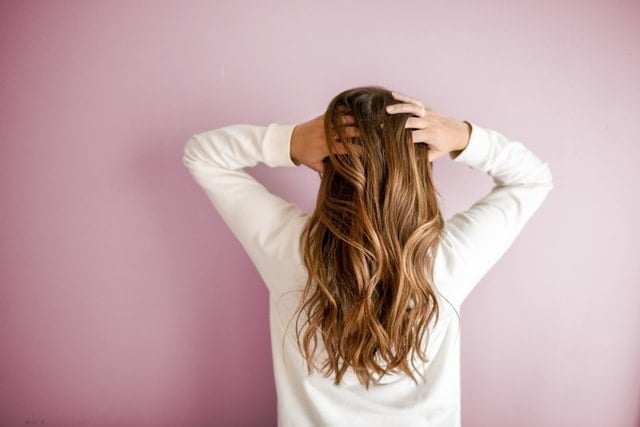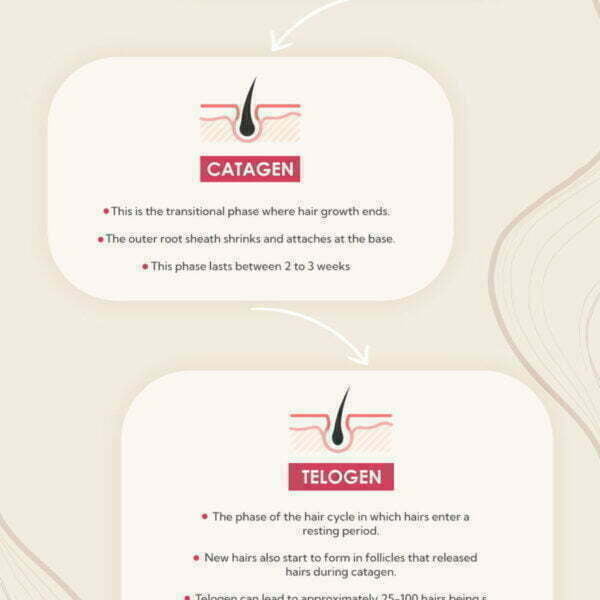Everyone’s hair goes through a life cycle. How that growth cycle is supported or disrupted depends on a number of factors: genetics, the products you use, your age, your diet, your psychological and physical health, and whether you are contending with underlying health issues or illness.
What is the hair cycle? What affects hair thinning, hair loss, and hair growth? We break this process down so you can understand the 4 phases better. We then offer suggestions on how to restore your hair’s health and achieve fuller, thicker hair!
4 Stages of Hair Cycle
Hair radically changes and influences how we look. While its growth is naturally cyclical, understanding these cycles can help us take control of how our hair looks and feels. There are 4 natural phases of hair growth to note.
The duration of these different phases impacts the length of hair in all parts of your body.
- The first stage is called anagen, in which active growth takes place.
- This is followed by catagen, a stage where there will be no more hair growth and the outer root sheath shrinks and attaches at the base of the follicle.
- Next is telogen, the hair’s resting phase.
- Finally, the last stage is exogen, where hair becomes loosely attached and sheds.
Structure of Hair
Hair has two parts: the follicle and the shaft. There are more than 100,000 scalp hair follicles. The shafts are made up of keratin protein and protected by cuticles to emerge from the follicles as eye-catching strands of hair.
Hair Follicles
In the hair cycle, follicles are tunnel-shaped sections of the epidermis that extend to the dermis. The living part of your hair is located below, around what we call a bulb, which is where growth takes place. Hair cells divide every 23 to 72 hours, which is significantly faster than any other cell in your body.
Hair Shafts
Hair shafts have three layers and contain keratin, the protein that protects the strand from damage. The main layer of hair is the medulla, and the second layer is called the cortex, which contains the pigment that gives your locks their hue.
What if the Hair Cycle Is Disrupted?
When hair growth is interrupted, you may experience hair thinning or hair loss. These symptoms are usually caused by conditions like metabolic imbalances, disease, or issues in one’s diet. For example, approximately 12 weeks after diet restriction or high fever, you may develop telogen effluvium, or sudden hair fall, as a result of hairs not staying in the anagen phase long enough for new ones to grow out.
Three Ways to Support Healthy Hair Growth & Improve Your Hair’s Life Cycle

Minimize Stress with Exercise and Calming Activities
The Mayo Clinic reports that high levels of stress play a role in premature balding; however, with regular exercise, meditation, breath work,or yoga, stressors can be minimized. While hair loss has other factors that simple lifestyle changes may not affect, making a conscious effort to reduce stress and anxiety may help improve the hair growth cycle. Explore ways that work for you to minimize your stress and reduce hair loss.
Maintain Good Nutrition
A consistent diet that includes all essential vitamins and minerals will help with your hair health, hair cycle, and growth rate. Hydration is also key! Men should aim to drink 15 cups of water per day, while women should have 11 cups daily. Work with your primary care physician to help establish the best dietary and nutrition plan for improving your health and lifestyle.
Consider a Hair Transplant
Robotic restoration procedures for an improved hair life cycle offer an advanced approach to addressing hair growth concerns. Offered at Salameh Plastic Surgery, this cutting-edge system provides unparalleled results and performance in the most advanced method available today, leaving no linear scarring or incision lines on the scalp.
ARTAS is a physician-assisted robotic hair procedure that is minimally invasive and yields permanent hair restoration results. Within three months of treatment, you will see visible hair growth. The most noticeable changes will be visible about six months after the procedure is completed and will be fully realized after approximately one year.

Maintaining healthy hair doesn’t have to be difficult when you understand the hair life cycle and choose to take control of your own hair’s growth. At Salameh Plastic Surgery, we are here to help empower you. Hair growth also depends on hair health, so by making the effort to eat right, get some exercise, and work with your primary care provider to optimize your health, you can take the steps toward a healthier look. To support your journey toward healthier and fuller hair, contact us today to learn about your options with Salameh Plastic Surgery.


